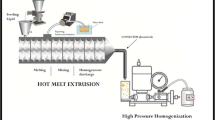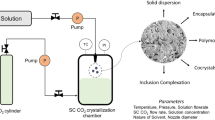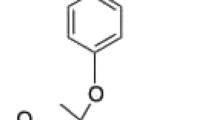Abstract
Purpose
In the present study, fenofibrate (a model drug with poor aqueous solubility) was micronized using the supercritical-fluid-assisted spray-drying (SA-SD) process to improve dissolution and biopharmaceutical property.
Methods
Solid-state characterizations including particle size analysis and dissolution test were carried out. To identify the main effects of SA-SD process parameters (such as pressure, temperature, concentration of drug solution, supercritical carbon dioxide (SC-CO2) injection rate, and drug solution injection rate) on the morphology and particle size distribution of micronized fenofibrate particles, a 27−3IV fractional factorial screening design was employed. Moreover, the effect of improved dissolution rate via micronization using SA-SD technology on the biopharmaceutical properties of fenofibrate was evaluated in a pharmacokinetic (PK) study in Sprague–Dawley rats.
Results
The results of the screening design showed that the mean particle size and distribution can be controlled by manipulating the drug solution concentration and CO2 injection rate. The SA-SD process resulted in a significant decrease in mean particle size (1.8–8.33 μm), as compared with that of unprocessed fenofibrate (24.2 ± 0.8 μm). There was a significant enhancement in the dissolution rate of micronized fenofibrate particles smaller than 5 μm compared to that of unprocessed fenofibrate. Moreover, an in vivo PK study in Sprague–Dawley rats showed that the increased dissolution rate improved biopharmaceutical properties (larger area under the curve and maximum serum concentration) of micronized fenofibrate than those of unprocessed fenofibrate.
Conclusion
Therefore, the SA-SD process is a useful micronization technology for improving both physicochemical and biopharmaceutical properties of poorly water-soluble drugs.







Similar content being viewed by others
References
Abuzar SM, Hyun S-M, Kim J-H, Park HJ, Kim M-S, Park J-S, Hwang S-J (2018) Enhancing the solubility and bioavailability of poorly water-soluble drugs using supercritical antisolvent (SAS) process. Int J Pharm 538:1–13
Amidon GL, Lennernas H, Shah VP, Crison JR (1995) A theoretical basis for a biopharmaceutics drug classification: the correlation of in vitro drug product dissolution and in vivo bioavailability. Pharm Res 12:413–420
Benet LZ, Amidon GL, Barends DM, Lennernas H, Polli JE, Shah VP, Stavchansky SA, Yu LX (2008) The use of BDDCS in classifying the permeability of marketed drugs. Pharm Res 25:483–488
Cha K-H, Cho K-J, Kim M-S, Kim J-S, Park HJ, Park J, Cho W, Park J-S, Hwang S-J (2012) Enhancement of the dissolution rate and bioavailability of fenofibrate by a melt-adsorption method using supercritical carbon dioxide. Int J Nanomed 7:5565
Chattopadhyay P, Gupta RB (2002) Supercritical CO2 based production of magnetically responsive micro- and nano-particles for drug targeting. Ind Eng Chem Res 41:6049–6058
Cho E, Cho W, Cha K-H, Park J, Kim M-S, Kim J-S, Park HJ, Hwang S-J (2010) Enhanced dissolution of megestrol acetate microcrystals prepared by antisolvent precipitation process using hydrophilic additives. Int J Pharm 396:91–98
Cho W, Kim M-S, Jung M-S, Park J, Cha K-H, Kim J-S, Park HJ, Alhalaweh A, Velaga SP, Hwang S-J (2015) Design of salmon calcitonin particles for nasal delivery using spray-drying and novel supercritical fluid-assisted spray-drying processes. Int J Pharm 478:288–296
Corrigan O, Crean A (2002) Comparative physicochemical properties of hydrocortisone-PVP composites prepared using supercritical carbon dioxide by the GAS anti-solvent recrystallization process, by coprecipitation and by spray drying. Int J Pharm 245:75–82
Costa C, Casimiro T, Aguiar-Ricardo A (2018) Optimization of supercritical CO2-assisted atomization: phase behavior and design of experiments. J Chem Eng Data 63:885–896
Cunha MSS, Martinez-Pacheco R, Landin M (2008) Dissolution rate enhancement of the novel antitumoral beta-lapachone by solvent change precipitation of microparticles. Eur J Pharm Biopharm 69:871–877
Duarte ARC, Costa MS, Simplicio AL, Cardoso MM, Duarte CMM (2006) Preparation of controlled release microspheres using supercritical fluid technology for delivery of anti-inflammatory drugs. Int J Pharm 308:168–174
Elvassore N, Baggio M, Pallado P, Bertucco A (2001) Production of insulin-loaded poly(ethylene glycol)/poly(l-lactide)(PEG/PLA) nanoparticles by gas antisolvent techniques. J Pharm Sci 90:1628–1636
Fages J, Lochard H, Letourneau J-J, Sauceau M, Rodier E (2004) Particle generation for pharmaceutical applications using supercritical fluid technology. Powder Technol 141:219–226
Falk RF, Randolph TW (1998) Process variable implications for residual solvent removal and polymer morphology in the formation of Gentamycin-loaded poly(l-lactide) microparticles. Pharm Res 15:1233–1237
Ghaderi R, Artursson P, Carlfors J (1999) Preparation of biodegradable microparticles using solution-enhanced dispersion by supercritical fluids (SEDS). Pharm Res 16:676–681
Graser F, Wickenhaeuser G (1982) Conditioning of finely divided crude organic pigments. US Patent 4,451,654
Guichard J, Blouquin P, Qing Y (2000) A new formulation of fenofibrate: suprabioavailable tablets. Curr Med Res Opin 16:134–138
Hanafy A, Spahn-Langguth H, Vergnault G, Grenier P, Grozdanis MT, Lenhardt T, Langguth P (2007) Pharmacokinetic evaluation of oral fenofibrate nanosuspensions and SLN in comparison to conventional suspensions of micronized drug. Adv Drug Deliv Rev 59:419–426
Hanna M, York P (1995) Method and apparatus for the formation of particles. WO Patent WO95/001221
Heinz A, Gordon KC, Mcgoverin CM, Rades T, Strachan CJ (2009) Understanding the solid-state forms of fenofibrate—a spectroscopic and computational study. Eur J Pharm Biopharm 71(1):100–110
Huang QP, Wang JX, Chen GZ, Shen ZG, Chen JF, Yun J (2008) Micronization of gemfibrozil by reactive precipitation process. Int J Pharm 360:58–64
Hwang SJ, Kim MS, Kim JS, Cha KH, Cho WK, Park JS, Seo SJ (2014) Manufacturing method and apparatus of ultrafine particles having uniform particle size distribution. US Patent 8,734,830
Junghanns J-UA, Müller RH (2008) Nanocrystal technology, drug delivery and clinical applications. Int J Nanomed 3:295
Kankala RK, Xu P-Y, Chen B-Q, Wang S-B, Chen A-Z (2021) Supercritical fluid (SCF)-assisted fabrication of carrier-free drugs: an eco-friendly welcome to Active Pharmaceutical Ingredients (APIs). Adv Drug Deliv Rev 176:113846
Kazarian S (2000) Polymer processing with supercritical fluids. Polym Sci Ser C 42:78–101
Kim JA, Paxton TE, Tomasko DL (1996) Microencapsulation of naproxen using rapid expansion of supercritical solutions. Biotechnol Prog 12:650–661
Kim M-S, Lee S, Park J-S, Woo J-S, Hwang S-J (2007) Micronization of cilostazol using supercritical antisolvent (SAS) process: effect of process parameters. Powder Technol 177:64–70
Kim J-S, Kim M-S, Park HJ, Jin S-J, Lee S, Hwang S-J (2008a) Physicochemical properties and oral bioavailability of amorphous atorvastatin hemi-calcium using spray-drying and SAS process. Int J Pharm 359:211–219
Kim M-S, Jin S-J, Kim J-S, Park HJ, Song H-S, Neubert RH, Hwang S-J (2008b) Preparation, characterization and in vivo evaluation of amorphous atorvastatin calcium nanoparticles using supercritical antisolvent (SAS) process. Eur J Pharm Biopharm 69:454–465
Kim M-S, Kim J-S, Hwang S-J (2010) Enhancement of wettability and dissolution properties of cilostazol using the supercritical antisolvent process: effect of various additives. Chem Pharm Bull 58:230–233
Knez Z, Weidner E (2003) Particles formation and particle design using supercritical fluids. Curr Opin Solid State Mater Sci 7:353–361
Li X, Gu L, Xu Y, Wang Y (2009) Preparation of fenofibrate nanosuspension and study of its pharmacokinetic behavior in rats. Drug Dev Ind Pharm 35:827–833
Lindenberg M, Kopp S & Dressman JB (2004) Classification of orally administered drugs on the World Health Organization model list of essential medicines according to the biopharmaceutics classification system. Eur J Pharm Biopharm 58:265–278
Ling H, Luoma JT, Hilleman D (2013) A review of currently available fenofibrate and fenofibric acid formulations. Cardiol Res 4:47
Lipinski C (2001) Avoiding investment in doomer drugs, is poor solubility an industry wide problem? Curr Drug Discov 4:17–19
Lipinski C (2002) Poor aqueous solubility—an industry wide problem in drug discovery. Am Pharm Rev 5:82–85
Lippold BC, Ohm A (1986) Correlation between wettability and dissolution rate of pharmaceutical powders. Int J Pharm 28:67–74
Loh ZH, Samanta AK, Heng PWS (2015) Overview of milling techniques for improving the solubility of poorly water-soluble drugs. Asian J Pharm Sci 10:255–274
Lu Y, Tang N, Lian R, Qi J, Wu W (2014) Understanding the relationship between wettability and dissolution of solid dispersion. Int J Pharm 465:25–31
Maltesen MJ, Bjerregaard S, Hovgaard L, Havelund S, Van De Weert M (2008) Quality by design–Spray drying of insulin intended for inhalation. Eur J Pharm Biopharm 70:828–838
McClellan AK, McHugh MA (1985) Seperating polymer solutions with supercritical fluids. Macromolecules 18:674–681
Meziani MJ, Pathak P, Hurezeanu R, Thies MC, Enick RM, Sun YP (2004) Supercritical-fluid processing technique for nanoscale polymer particles. Angew Chem Int 3:704–707
Meziani M, Pathak P, Beacham F, Allard L, Sun Y (2005) Nanoparticle formation in rapid expansion of water-in-supercritical carbon dioxide microemulsion into liquid solution. J Supercrit Fluids 34:91–97
Moshashaee S, Bisrat M, Forbes R, Quinn E, Nyqvist H, York P (2003) Supercritical fluid processing of proteins: lysozyme precipitation from aqueous solution. J Pharm Pharmacol 55:185–192
Moura C, Casimiro T, Costa E, Aguiar-Ricardo A (2019) Optimization of supercritical CO2-assisted spray drying technology for the production of inhalable composite particles using quality-by-design principles. Powder Technol 357:387–397
Noyes A, Whitney W (1987) The rate of solution of solid substances in their own solutions. J Am Chem Soc 19:930–934
Pasquali I, Bettini R (2008) Are pharmaceutics really going supercritical? Int J Pharm 364:176–187
Pasquali I, Comi L, Pucciarelli F, Bettini R (2008) Swelling, melting point reduction, and solubility of PEG 1500 in supercritical CO2. Int J Pharm 356:76–81
Pathak P, Meziani MJ, Desai T, Sun YP (2004) Nanosizing drug particles in supercritical fluid processing. J Am Chem Soc 126:10842–10843
Paudel A, Worku ZA, Meeus J, Guns S, Van Den Mooter G (2013) Manufacturing of solid dispersions of poorly water soluble drugs by spray drying: formulation and process considerations. Int J Pharm 453:253–284
Perrut M, Jung J, Leboeuf F (2005) Enhancement of dissolution rate of poorly-soluble active ingredients by supercritical fluid processes: part I: micronization of neat particles. Int J Pharm 288:3–10
Porta G, Reverchon E (2005) Engineering powder properties by supercritical fluid for optimum drug delivery. Part two: supercritical-assisted atomisation. BioProcess Int 3:54–60
Rathbone MJ, Hadgraft J, Roberts MS (2003) Modified release drug delivery technology. Marcel Dekker, New York
Reverchon E (2002) Supercritical-assisted atomization to produce micro- and/or nano particles of controlled size and distribution. Ind Eng Chem Res 41:2405–2111
Reverchon E, Marco I (2004) Supercritical antisolvent micronization of cefonicid: thermodynamic interpretation of results. J Supercrit Fluifs 31:207–215
Rodier E, Lochard G, Sauceau M, Letourneau J, Freiss B, Fages J (2005) A three step supercritical process to improve the dissolution rate of Eflucimibe. Eur J Pharm Sci 22:1–17
Savla R, Browne J, Plassat V, Wasan KM, Wasan EK (2017) Review and analysis of FDA approved drugs using lipid-based formulations. Drug Dev Ind Pharm 43:1743–1758
Seckner AJ, Mcclellan AK, Mchugh MA (1988) High solution behavior of the polymer-toluene-ethane system. AIChE 34:9–16
Sethia S, Squillante E (2002) Physicochemical characterization of solid dispersion of carbamazepine formulated by supercritical carbon dioxide and conventional solvent evaporation method. J Pharm Sci 91:1948–1957
Sievers RE, Karst U (1997) Methods and apparatus for fine particle production. US Patent 5,639,411
Snavely W, Subramaniam B, Rajewski R, Defelippis M (2002) Micronization of insulin from halogenated alcohol solution using supercritical carbon dioxide as an antisolvent. J Pharm Sci 91:2026–2038
Ventosa N, Sala S, Veciana J (2003) DELOS process: a crystallization technique using compressed fluids: 1. Comparison to the GAS crystallization method. J Supercrit Fluids 26:33–45
Vogt M, Kunath K, Dressman JB (2008) Dissolution enhancement of fenofibrate by micronization, cogrinding and spray-drying: comparison with commercial preparations. Eur J Pharm Biopharm 68:283–288
Wang Y, Wei D, Dave R, Pfeffer R, Sauceau M, Letourneau J, Fages J (2002) Extraction and precipitation particles coating using supercritical CO2. Powder Technol 127:32–44
Weidner E, Petermann M, Blatter K, Rekowski V (2001) Manufacture of powder coatings by spraying of gas-enriched melts. Chem Eng Technol 24:529–533
World Health Organization, WHO (2021) WHO model list of essential medicines, 22nd list. Geneva: World Health Organization; 2021 (WHO/MHP/HPS/EML/2021.02). Licence: CC BY-NC-SA 3.0 IGO
Yang B, Wei C, Qian F, Li S (2019) Surface wettability modulated by surfactant and its effects on the drug release and absorption of fenofibrate solid dispersions. AAPS PharmSciTech 20:1–10
Young TJ, Mawson S, Johnston KP, Henriksen IB, Pace GW, Mishra AK (2000) Rapid expansion from supercritical to aqueous solution to produce submicron suspensions of water-insoluble drugs. Biotechnol Prog 16:402–407
Young T, Johnston K, Pace G, Mishra A (2004) Phospholipid-stabilized nanoparticles of cyclosporine a by rapid expansion from supercritical to aqueous solution. AAPS PharmSciTech 5:70–85
Acknowledgements
This research was supported by the Basic Science Research Program through the National Research Foundation (NRF) of Korea funded by the Ministry of Education (2016R1A6A1A03007648). This work was supported by the Mid-Career Researcher Program (No. NRF-2021R1A2C2008834) and Basic Research Infrastructure Support Program (University-Centered Labs-2018R1A6A1A03023718) through the National Research Foundation of Korea (NRF) funded by the Korean government (MSIT). This work was supported by the National Research Foundation of Korea (NRF) grant funded by the Korea government (MSIT) (No. 2020R1A2C4002166).
Author information
Authors and Affiliations
Corresponding authors
Ethics declarations
Conflict of interest
All authors (J.-S. Kim, H. Park, K.-T. Kang, E.-S. Ha, M.-S. Kim, and S.-J. Hwang) declare no conflict of interest.
Research involving human and animal rights
The animal study was conducted according to the guidelines of the Care and Use of Laboratory Animals, and approved by the Institutional Review Board of the nonclinical contract research organization, KPC laboratory (Approved Protocol Code: I-1708186, Date of Approval: 29 August 2017).
Additional information
Publisher's Note
Springer Nature remains neutral with regard to jurisdictional claims in published maps and institutional affiliations.
Rights and permissions
About this article
Cite this article
Kim, JS., Park, H., Kang, KT. et al. Micronization of a poorly water-soluble drug, fenofibrate, via supercritical-fluid-assisted spray-drying. J. Pharm. Investig. 52, 353–366 (2022). https://doi.org/10.1007/s40005-022-00565-z
Received:
Accepted:
Published:
Issue Date:
DOI: https://doi.org/10.1007/s40005-022-00565-z




